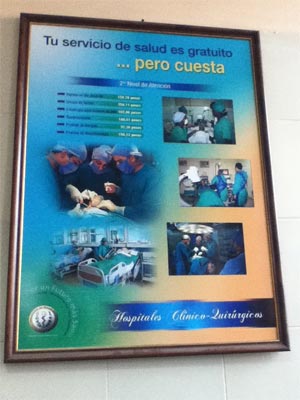Studying medicine in Cuba and making a point at Stanford’s expense
Graham Sowa

HAVANA TIMES — The medical books I use in Cuba come from a variety of sources. There are Spanish translations of United States published textbooks such as Harrison’s Principals of Internal Medicine. There are Spanish translations of Soviet Union textbooks such as Sinelnikov’s Atlas of Anatomy. There are also Cuban published textbooks.
Since first year I’ve been studying from Propedeuitca Clinica, a Cuban book, by Dr. Raimundo Llanio Navarro. Every year our textbooks are loaned (free to us, but I understand someone had to pay for them) and every year Propedeutica Clinica is there among them. For that, many of us have come to know it more simply as “Llanio”.
Llanio comes in two tomes. The first tome focuses on how to do a correct physical exam. The second teaches alterations to the normal physical exam and internal medicine. The key here is that the physical exam is linked to internal medicine by various medically significant symptoms and signs, defined by Llanio as propedeutica.
Despite much creative thinking and scouring of medical dictionaries my fellow English speaking friends and I have decided that an English translation of propedeutica probably doesn’t exist. This is unfortunate because I believe the extended amount of time we spend focused on propedeutica, with its study of signs and symptoms in the context of the physical exam, is one of the main differences between medical education in Cuba and most other places in the world.
This focus started early in our medical education. I remember opening Llanio the first week of the first year of medical school. I also remember how we would get in groups in class and practice various forms and components of the physical exam on each other. Of course what I don’t remember is every single step of every part of every physical exam. Which makes we wish I would have taken all of this propedeutica stuff a lot more seriously at the time.
Now, in the first half of third year, we are learning alterations to patient symptoms and physical exam findings brought on by disease.
This semester, with its primary focus on learning internal medicine through the physical exam, is one of the reasons medical school in Cuba is six years duration instead of four years as it is in the United States. Next semester we will take a more “textbook” approach to internal medicine with a focus on complementary laboratory tests, treatment, and patients with more than one illness.
All of this is done in the midst of working in a hospital. So basically we are talking about a one year rotation in internal medicine. And as complicated as medicine is I’ll probably figure out what is going on the last month of the whole ordeal.
As it turns out it is more economical to do a better physical exam than a bunch of lab tests that come back with a lot of negative results. Physical exams also help build better patient-doctor relationships. Good patient-doctor relationships have been proven to decrease legal action of the former against the latter. Some people in the United States have taken notice of this.
Here I am more than subtly referring to what Stanford University has newly christened “The Stanford 25.” Brought about by the increasingly popular views of the back-to-the-basics crowd in the United States, such as physician-author Abraham Verghese, “The Stanford 25” is nothing more than a collection of 25 physical exams Stanford University expects its medical students to master.
Of course it takes a certain amount of hubris to rename 25 useful physical exams simply because Stanford University now deems them important. For example, one of the “Stanford 25” physicals is the thyroid exam. I know this exam, from Llanio, as the Quervain, Lahey and Crile maneuvers.
But if Stanford is willing to reemphasize the physical exam as long as they get to re-eponymize it as well I guess medicine is still the better for it. I’m glad I got to know the exam for what it once was called, and I hope that I have a better appreciation of its history for that.






I ‘ve belonged to Kaiser Hawaii for 13 years. Before that I was a member of Group Health in Seattle since it was formed by various Unions in 1948. Kaiser is a non-profit – kind of, GH is a co-op, and the members elect the Board of Directors etc. I have a lifetime membership, and if I return to Washington, I can resume my membership and voting privileges. GH doctors believe in physical exams, starting with a handshake, when the doctors comes into the exam room. According to my GHG Physician and a couple of acupuncturists I’ve visited with, this simple act provides quite a bit of info to someone who is looking for it.
Kaiser believes in all kinds of lab work and x-rays, but the doctors seem to be allergic to touching a patient. Since computers have replaced conversation with the patient, it has become even worse.
This is a pet peeve of mine, and one I complain about often. I was very pleased that at least some Med Students are learning how to pay attention to physical symptoms rather that lab tests. A good friend died of liver cancer. his regular doctor treated him for a skin allergy for 2 years, never noticing the increasing jaundice. He was Chinese, but even so, there were signs that should have alerted the doctor enough to at least order a liver function test, before the cancer was stage 4.
Good luck with your studies. Whoever gets you as their Doctor will surely appreciate a Doctor who pays attention to THEM, rather than the computer screen.